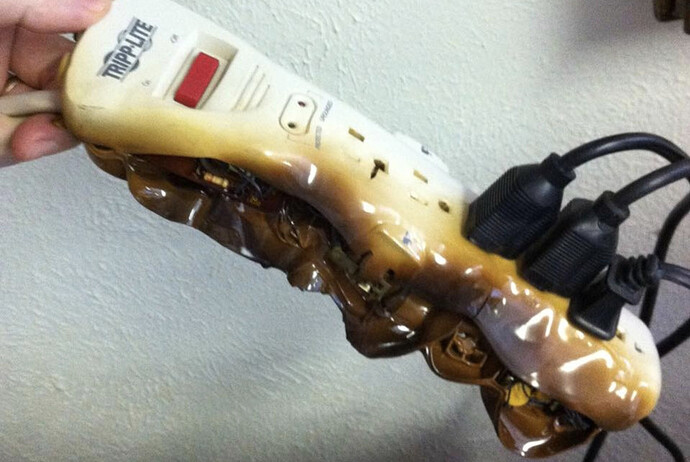Mine has run on a non-protected strip since day one. My home also has a whole house surge protector in the breaker panel.
It’s extremely common for appliance instructions to say things like “use only the included cord”. Pure legalese. First, if something goes wrong with a part they didn’t supply, they don’t want to be blamed. Second, if equipment they didn’t supply breaks their equipment, they don’t want a warranty claim.
I have an appliance and its manual first states that they supplied a short (3 ft) power cord for safety. They then go on to say you should use it 6 feet from any wall.
I will just add my two cents that as long as that cord is in good condition and you are not using it to power anything else, it will work fine for your glowforge.
Part of the issue is that power strips are notoriously poor quality, as is many extension cords. House wiring generally passes an inspection and meets code. Generally (I’ve seen some shoddy hacks in my day).
But power strips? They should pass inspection… but, yeah, ain’t nobody got time for that when the factory is cranking out 18zillion $3 power strips.
This is an example (not mine, thankfully) of a cheap power strip with a space heater plugged in.
A Tripp-Lite Super 7 power strip. Ironically the specification say “15A resettable circuit breaker foils dangerous overloads”. Oops!
That’s the other issue; might well be counterfeit. Counterfeit product sold via Amazon is unfortunately common.
Many appliances have this disclaimer. Most people ignore it. Heck, a lot of computers say the same thing and you’d be hard pressed to find a desktop computer anywhere that isn’t plugged into a power strip.
The problem is that most power strips are made with the absolute bare minimum materials to function. They use super thin and super cheap internal wires. No matter how safe the strip is, most electrical appliances work better when they are supplied by thicker wiring. It is a barely noticeable issue for the short distances involved inside a power strip, but it’s still there. If your strip has a long cord with thin internal wiring it may be more noticeable. If you are in the US and your house was built or re-wired after the 1940’s, the outlet on your wall has 14 gauge wire at a minimum (most likely 12 gauge solid copper wire) firmly attached to a receptacle that is rated for 20 amps.
A power strip with the same specs will probably cost you quite a bit more than most people want to spend, and they are not as readily available as the cheaper strips. Most people will buy the 3 dollar power strip and assume it’s good because, “they can’t sell an unsafe one, right?”. Power strips are also often associated with sloppy installs where damage to the wiring from foot traffic in the area can be a concern. People also often plug multiple high-draw appliances into one strip, which can cause multiple problems, not the least of which is fire. Another issue can be electrical interference from other appliances, which can occur with regular house wiring, but would be increased if the culprit of the interference is plugged into the same power strip as an appliance that is sensitive to interference.
That said, I personally wouldn’t worry much about putting my GF on a high-quality strip that’s rated for at least 15 amps. You can buy those for under 20 bucks. I’d just limit what else I put on there and make sure I protect the set-up from physical damage.
This topic was automatically closed 32 days after the last reply. New replies are no longer allowed.
